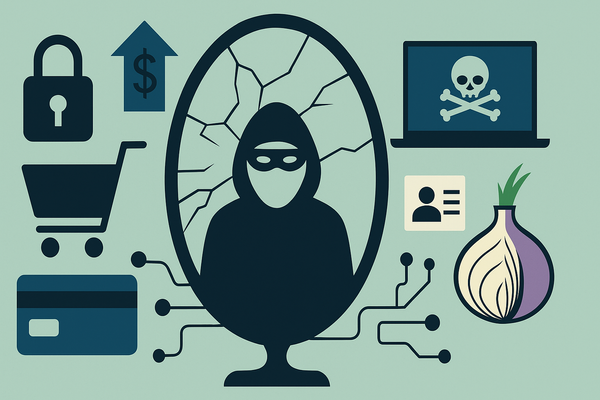Mirror in the Dark: What the Darknet Tells Us about Ourselves

For most, the darknet spurs images of shadowy hackers, illegal marketplaces, and underground crime rings. While there is some truth in all of these images, it's a distorted reflection of our society. It's actually more like a mirror that depicts the desires and vulnerabilities of the people using the darknet.
From privacy to profit: origins of the darknet
There was a time when the darknet was only a hidden network layered underneath the internet we know today. In fact, its ancestor was ARPANET, the foundation of the internet, which was built from the outset to prioritize privacy, security, and anonymity.
Today's darknet is accessed via specialized tools like Tor or I2P (although many others are available) and remains true to those roots. It's still built to provide anonymity and privacy, but the same features have attracted savvy criminals.
Unfortunately, just as regular users value the inherent security built into the system, so do cybercriminals. The anonymity of the darknet has inadvertently provided a haven to a thriving digital underworld.
A reflection of human nature
To gain a better grasp of the darknet, we must first understand that it is a human-driven ecosystem. At its core it's neither good nor evil; it's simply driven by what people want. And, for the most part, people are driven by economic factors. They want cheaper streaming accounts, stolen credit cards (free money) and financial information, drugs, weapons, and illegal digital services. Ultimately, everything is reduced to money.
And like all digital avenues, all users can be separated into two major categories: sellers and buyers.
Cybercrime-as-a-service
One of the most significant impacts of the darknet is the democratization of cybercrime, which lowers barriers to entry. Offerings like Ransomware-as-a-Service (RaaS) where you can rent malware and infrastructure, allow those with little or even no technical knowledge to launch cyberattacks.
Criminal marketplaces offer:
- Subscription-based ransomware tools.
- Complete kits for financial fraud (fake credit cards, cloned IDs).
- Readily available hacking services targeting email accounts, banking platforms, and social media.
Just as online tutorials and boot camps have democratized coding, the darknet has democratized hacking. There are people who want to buy this knowledge, and there will always be those ready to sell it.
Here are a couple of examples of an RaaS advertisement and demand for hacker knowledge:


The criminal e-commerce experience
Just like traditional online storefronts, darknet marketplaces have adopted strategies of big businesses like Amazon or eBay by offering guarantees, reviews, customer support, and even refunds, creating an illusion of legitimacy and trust.
For instance, stolen credit cards are sold with guaranteed balances. Illicit drug markets provide detailed shipping options and stealth packaging to ensure privacy. They provide shipping options and a sense of privacy.


Yet beneath this seemingly professional exterior lies the inevitable deception. Scammers target not just naive outsiders but even experienced cybercriminals. There's a high chance of getting scammed on the darknet.
Trust is dead on the darknet
If trust is the currency of commerce, deceit is clearly the currency of the darknet. Fraud is everywhere, with countless listings offering items like fake hacking tools or nonexistent goods at suspiciously low prices.


This mirrors broader digital day-to-day experiences like misinformation, phishing, deepfakes, and financial scams. The darknet amplifies what already exists on the regular internet.
Our digital lives for sale
On the darknet, our stolen digital lives are on display. Stolen streaming service accounts (Netflix, Disney+), Amazon accounts with stored credit cards, databases filled with personal information, and even fake IDs are bought and sold with frightening ease.

Stolen streaming services are not the only ones readily available. Information from data breaches often ends up on the darknet, usually for sale at low prices. Our data and privacy are valuable, but for criminals, it's money.


Living off the land
According to Bitdefender Labs, 84% of high-severity incidents in 2025 involved attackers using LOTL (Living off the Land) techniques — tools already built into operating systems.
Just like ransomware, LOTL frameworks are rented on darknet markets.

Conclusion: confronting our digital reflection
The darknet echoes society's behavior, reflects trends, and amplifies human vices.
Learning about this hidden side of the internet helps the public understand the risks they face. Most people only hear vague warnings about how a data breach compromised their passwords and credentials that are now up for sale.
The most effective way to remove the darknet's mysterious aura and help the public protect their interests is to shine a light on it and truly understand how it works.
Knowing how the darknet operates is the first step in helping people recognize the value of their digital lives, why they are of interest to criminals, and what they can do to remain as safe as possible.